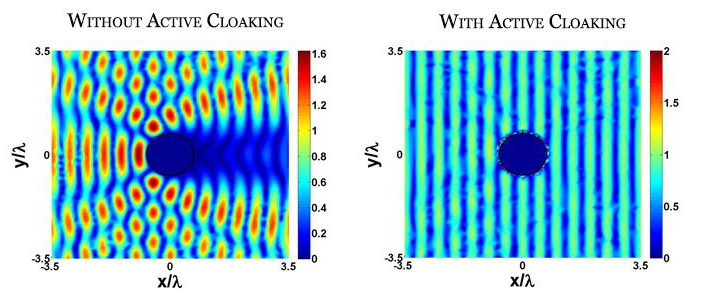In literature and film, invisibility has long been a sought after ability that brings the promise of ultimate wealth and power. Therefore, it is with both excitement and caution that I suggest science may soon succeed in conferring invisibility on a person or object. Some such developments into invisibility have recently been achieved by an undergraduate student at the University of St Andrews, where I achieved my degrees. It therefore seems apt to write about invisibility in my first feature blog post, and I'd like to pre-empt the comparisons between St Andrews and Hogwarts by making one myself.

Credit: University Of St Andrews
Invisibility as a feature of literature is more prominent in fantasy than in science fiction, though it is slowly becoming a science reality. In fantasy, it is often an object, whether a cloak or a cap, that imparts invisibility on its wearer. In science fiction, 'cloaking' of large objects like spaceships and buildings is achieved with the assumption of a pseudo-scientific explanation that is rarely elaborated upon. Sometimes in fantasy and SF, invisibility is achieved by mind control techniques that cause the viewer's mind to edit out the subject. Whereas 'cloaking' in science fiction usually has a functional or military purpose, invisibility in fantasy is often portrayed as a tempting ability that draws its users into acts of scheming and misadventure. It's usually an individual who has the power of invisibility and the power it grants inevitably corrupts. It therefore seems that we pursue the dream of invisibility with a Machiavellian-like zeal. However, the methods by which we achieve invisibility may pose limitations on its use and influence the implications it may have. Would technology that imparts invisibility be destined to be used for immoral and selfish acts? Or would its applications stretch to benefiting wider society?
How do you make something invisible?
The basics of invisibility are very simple. It all depends on light, and how it interacts with the object we're looking at.
Objects are made visible by the light reflected off their surfaces, which is detected by the retinas of our eyes. Therefore, to make something invisible, light must be prevented from being reflected off its surface. As a result, the design of invisibility cloaks works on the basis of bending light around a 'cloaked' object, instead of allowing it to be reflected.
Most research into invisibility is focused on producing appropriate metamaterials - these are artificial materials engineered to have properties not found in nature. Natural materials have a positive refractive index, which controls how light waves interact with them. The refractive index depends on the material's internal structure, which is altered in metamaterials to change the properties of the material. Research investigating materials with a negative refractive index is crucial to the pursuit of invisibility.
While the idea of metamaterials sounds like it could recreate the perfect design, it has its limitations. Such materials would have fundamental properties that would inhibit perfect invisibility.
Firstly, the materials need to be highly dispersive, so they can bend light waves around the 'cloaked' object. However, this also means light would be strongly refracted, with some traveling back towards the eye. This would distort the view of the object, but not render it invisible. For example, light is refracted by different amounts as it passes through a prism; this results in a rainbow of light.
Secondly, the shield around the 'cloaked' object will appear partially opaque, as light passing through the metamaterial is partially absorbed.
Thirdly, light needs to be accelerated to 'bend' around an object. It can only be achieved under particular conditions and therefore restricts invisibility cloaks to work only at a single wavelength frequency. This would mean the cloak would work only upon one colour.
Work undertaken at the University of St Andrews by Janos Perczel, alongside invisibility expert Professor Ulf Leonhardt, has gone some way to solving this third problem. Researchers have developed a spherical optical device, the purpose of which is to slow down light. This sphere would mean the light is not accelerated to such high speeds and therefore is able to work across all parts of the spectrum. The invisibility cloak created with this design would work against a backdrop of various colours and would allow the wearer to move around in front of such backgrounds, even ones that are constantly changing.
Shields up. Cloaking enabled.
Thick coatings of metamaterials are fine for small objects, but are not so practical when attempting to cloak large objects.
Early in 2013, Michigan Technological University announced a system of cloaking that works for radio waves, using a dielectric coating to reflect waves of electromagnetic radiation. This means the object can appear invisible to radar, and furthermore, the cloak can send signals to make the object appear larger, smaller, or in a different location. Surprisingly, the researchers have achieved this through use of natural materials, with varying levels of dielectric permittivity (the measure of how a substance responds to an electric field), instead of metamaterials. The results of this approach were published in the American Institute of Physics journal, Applied Physics Letters.
Later in the year, The University of Toronto revealed a cloaking device that works by similar methods. Instead of a dielectric coating, however, the lightweight device is covered in an ultra-thin layer of antennae. These emit a signal that does not simply distort radar reflection, but cancels it out entirely.
This technology is still in the early stages of development, but it has military applications, rendering objects invisible to radar. Yet this is a far cry from making an object invisible in the spectrum of visible light. Perhaps in time this technology could be adapted to different wavelengths to make objects invisible to the naked eye.

The device before and after the electromagnetic field is generated.
Credit: Marit Mitchell / University of Toronto
Augmented Reality allows for optical camouflage, making an object appear invisible. A video camera positioned behind the subject captures an image that is projected onto the subject's highly-reflective clothing, or 'cloak.' The viewer needs to perceive both the perspective-altered image projected onto the subject and the light from the surrounding world to have created the illusion of invisibility. This method has considerable limitations when the subject begins to move, however some of its practical applications are detailed later in this article.
Has science lived up to the SF/fantasy dream?
As the current research suggests that the way to render an object invisible is by covering it in a metamaterial, the idea of an invisibility 'cloak' seems more likely than other literary suggestions of magic rings and caps conferring invisibility.
However, an invisibility cloak would become easily lost if it was invisible even when it is not being worn. Therefore, it seems that invisibility cloaks of literature are capable of modifying themselves when they are being used to cloak a human being or an object, as if they have some kind of consciousness. In order to achieve this with science, the cloak would need some way of detecting when it is being used for an intended purpose. Perhaps it could detect a pattern of infra-red to identify when it is covering a human being or animal, but this would mean it could only be used to cover living creatures. Also, it could very easily disappear if moved by a pet dog or cat, commandeered for use as a dissatisfying chewy toy.
In folklore, there is more often an invisibility cap than a cloak. It seems to represent a token which confers the ability to become invisible, as if granting permission. Such technology, if at all possible, would only be possible in the distant future, and would become a matter for biology and genetics. Speculation into the matter might involve coding genes that control the visibility of individual cells, and some method by which they could make the switch, perhaps by chemical means, or by a change in temperature.
Following in the folkloric tradition, the ring of power in Tolkien's The Lord of the Rings is a token that confer invisibility on its wearer. The ring corrupts its bearer, as they become aware of its power and how they could use it. The trend in literature and film seems to be that invisibility is a corrupting influence, a shield conferring anonymity for immoral and self-serving deeds, preventing justice from being carried out. However, the power for invisibility in J K Rowling's Harry Potter series is generally used for good. Of course, the use of the invisibility cloak means breaking the school rules, an act of apparent mischief, but the protagonists are acting for a greater cause, an ultimately moral goal.
In his 1897 novel, The Invisible Man, H G Wells explains a method by which he believes invisibility could be made possible. In Chapter XIX, the invisible scientist, Griffin, explains how he succeeded in making himself invisible. His method is based on the "action of visible bodies on light," and claims that objects can be made invisible by changing the refractive index of a substance to that of air, so that it reflects no light. This method sounds very similar to investigation into producing metamaterials with an altered refractive index. However, whereas Wells intended to change the properties of the material he wanted to make invisible, a more likely solution would require the 'cloaked' object being coated in a metamaterial with an altered refractive index. This is particularly important because certain organs in the human body rely upon absorbing light and not simply letting it through. Griffin notes how the invisible cat's eyes, with their highly reflective Tapetum Lucidum, resist being made invisible, but he does not address the matter of human eyes. Wells' invisible man would be blind if his eyes were not capable of absorbing light.
Griffin also fails to explain how the refractive index of substances could be altered. He glosses over what he calls the "complicated processes" but describes how "the transparent object whose refractive index was to be lowered between two radiating centres of a sort of ethereal vibration," driven by "two little dynamos, and these I worked with a cheap gas engine. My first experiment was with a bit of white wool fabric. It was the strangest thing in the world to see it in the flicker of the flashes of soft and white, and then to watch it fade like a wreath of smoke and vanish."
Like the ring in The Lord of the Rings, the power of invisibility corrupts the protagonist, who becomes driven by greed, and is driven to immoral deeds by his situation. "I was only just beginning to realise the extraordinary advantage my invisibility gave me. My head was already teeming with plans of all the wild and wonderful things I has now impunity to do."
There seems to be a pattern, linked to the method by which the protagonists came about their magical items. Harry Potter's cloak originally belonged to his father, and so passed down as legitimate inheritance. Griffin steals money from his father to complete his research into invisibility, following which his father commits suicide, and so his gift is the result of corrupted inheritance. The ring in The Lord of the Rings was stolen by Smeagol/Gollum and by Bilbo Baggins, both of whom feel the influence of its corrupting power.
Whereas the power to become invisible in literature often draws characters into misdemeanour, and adventures involving deceit and espionage, the real life applications of such camouflaging technology would be far different. Drivers could see through the entire rear of their vehicles using augmented reality, so they would not need to rely on mirrors and would have no need to worry about blind spots. The cockpits floors of aeroplanes could be made transparent, so pilots could see the landing gear of the plane by looking down through the plane (which would display a projection recorded from the outside of the fuselage). Surgeons would be able to see 'through' their hands so their view of the operating table would not be obscured.
While progress is being made towards making invisible large or moving objects using metamaterials, there are significant limitations to overcome and some that may be impossible to successfully rectify. The optical illusion may not ever be perfect enough to fool the human eye, but this does not mean that the technology does not have a multitude of useful applications. So far, literature and film's portrayal of invisibility is one limited in its outlook, but perhaps these recent developments will cause writers to see alternative uses for invisibility.
References & Further Reading
- Wang & Semouchkina, "A Route For Efficient Non-Resonance Cloaking By Using Multilayer Dielectric Coating", Applied Physics Letters (2013)
- Perczel, Tyc & Leonhardt, "Invisibility Cloaking Without Superluminal Propagation", New Journal of Physics (2011)
- Wells, "The Time Machine and The Invisible Man", Signet Classics (1984)
Listing image: Warner Bros
